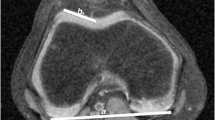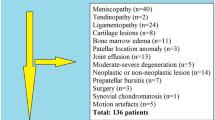Abstract
Background
The Insall–Salvati ratio is a technique for determining patellar height that relies on bony landmarks. Magnetic resonance imaging (MRI) and plain radiography are used interchangeably to assess the Insall–Salvati ratio in the pediatric population despite the lack of validity in the literature.
Objective
The purpose of this study was to investigate if the Insall–Salvati ratio and patella alta as determined on MRI are comparable to those determined on radiography in pediatric patients.
Materials and methods
We conducted a retrospective review of 49 pediatric patients (age range: 7.5–17.0 years) with unfused growth plates who underwent both knee MRI and lateral knee radiography. Measurements for calculating the Insall–Salvati ratio (the ratio of patella tendon length to patella length) were obtained by three observers. Data were analyzed using paired t-tests and Pearson’s correlation. A reliability assessment and inter-method agreements were performed. Patella alta was defined as an Insall–Salvati ratio > 1.2. Additional cutoffs of Insall–Salvati ratios > 1.3 and > 1.4 were also analyzed.
Results
There was no statistically significant difference between Insall–Salvati ratio as determined on MRI (mean: 1.20) and radiographs (mean: 1.25; P > 0.05). There was a strong correlation between Insall–Salvati ratio as determined on MRI and radiographs (Pearson’s r = 0.6) with moderate consistency (Cronbach’s alpha = 0.78). There was a good level of agreement between the diagnosis of patella alta on MRI and radiographs when defined as an Insall–Salvati ratio greater than 1.2 and 1.3 (Cohen’s kappa = 0.61).
Conclusion
The results demonstrate a strong association between Insall–Salvati ratio and patella alta derived from MRI and radiographs in children ages 7.5 years and older.


Similar content being viewed by others
References
Miller TT, Staron RB, Feldman F (1996) Patellar height on sagittal MR imaging of the knee. AJR Am J Roentgenol 167:339–341
Degnan AJ, Maldjian C, Adam RJ et al (2015) Comparison of Insall-Salvati ratios in children with an acute anterior cruciate ligament tear and a matched control population. AJR Am J Roentgenol 204:161–166
Insall J, Salvati E (1971) Patella position in the normal knee joint. Radiology 101:101–104
Kannus PA (1992) Long patellar tendon: radiographic sign of patellofemoral pain syndrome. Radiology 185:859–863
Walker P, Harris I, Leicester A (1998) Patellar tendon-to-patella ratio in children. J Pediatr Orthop 18:129–131
Giovagnorio F, Olive M, Casinelli A et al (2017) Comparative US-MRI evaluation of the Insall-Salvati index. Radiol Med 122:761–765
Lee PP, Chalian M, Carrino JA et al (2012) Multimodality correlations of patellar height measurement on x-ray, CT, and MRI. Skeletal Radiol 41:1309–13143
Verhulst FV, van Sambeeck JDP, Olthuis GS et al (2020) Patellar height measurements: Insall-Salvati ratio is most reliable method. Knee Surg Sports Traumatol Arthrosc 28:869–875
Laugharne E, Bali N, Purushothamdas S et al (2016) Variability of measurement of patellofemoral indices with knee flexion and quadriceps contraction: n MRI-based anatomical study. Knee Surg Relat Res 28:297–301
Shabshin N, Schweitzer ME, Morrison WB, Parker L (2004) MRI criteria for patella alta and baja. Skeletal Radiol 33:445–450
Park MS, Chung CY, Lee KM et al (2010) Which is the best method to determine the patellar height in children and adolescents? Clin Orthop Relat Res 468:1344–1351
Author information
Authors and Affiliations
Corresponding author
Ethics declarations
Conflicts of interest
None
Additional information
Publisher’s note
Springer Nature remains neutral with regard to jurisdictional claims in published maps and institutional affiliations.
Rights and permissions
About this article
Cite this article
Kurowecki, D., Shergill, R., Cunningham, K.M. et al. A comparison of sagittal MRI and lateral radiography in determining the Insall–Salvati ratio and diagnosing patella alta in the pediatric knee. Pediatr Radiol 52, 527–532 (2022). https://doi.org/10.1007/s00247-021-05207-4
Received:
Revised:
Accepted:
Published:
Issue Date:
DOI: https://doi.org/10.1007/s00247-021-05207-4




